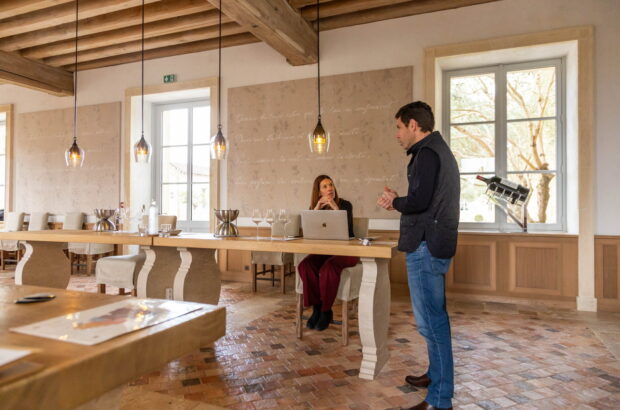The extensive Saadé family was one of Syria’s largest landowners: Latakia-based Orthodox Christians whose agricultural wealth developed industrial and trading offshoots in Syria itself, as well as in Lebanon, Cyprus and elsewhere. The family lost all its land and factories in the confiscations and nationalisations which accompanied the short-lived 1958-1961 United Arab Republic, when Syria temporarily unified with Egypt; but it continued its trading and shipping activities. Under Johnny Saadé, this branch of the family decided to return to the land via wine production in the late 1990s.
Inspired by the renown of Syria’s wines in the ancient world, and noting that the best wines of both the Bekaa Valley in Lebanon and the Golan Heights were produced at altitude, Johnny and his sons Karim and Sandro planted 900m up in Syria’s coastal mountains, on the ancient Mount Bargylus (now Jebel el Ansārīye), in 2003. Their consultant, Stéphane Derenoncourt, visited with them in 2005. The first wine was launched in 2006. Among journalists visiting in 2009 was Michael Karam, author of Wines of Lebanon (Saqi Books, 2005) and more. The sun shone. As the Arab Spring unfolded in 2011, a new Middle East seemed briefly possible.
Uprisings in Syria were swiftly crushed, though, and the long, harrowing and immensely destructive Syrian civil war began. The violent fundamentalists of Isis surged across Syria from Iraq in 2013. At one point in 2014, the fighting came within 200 metres of the vineyards. The Saadé brothers have been unable to visit their vines since 2011. Since then, they’ve run the vineyard and supplied the winery remotely, from Beirut to the south, using taxis. New barrels sitting in passenger seats, heading north; grape samples as harvest nears, heading back south. Matters worsened. Lebanon lurched into an unparalleled economic and financial crisis in 2019 as it tried to cope with 1.5 million Syrian refugees, political corruption and administrative deadlock. Its currency disintegrated; hyperinflation took hold. Covid struck.
Then came the colossal Beirut port explosion of August 2020: Johnny, Karim and Sandro were in their family office, just 600m away. Sandro and Johnny were badly injured by a flying door, glass and debris. It took them an hour to struggle out of the ruins; Johnny, in his eighth decade, was in intensive care for two weeks. Finally, on the night of 6 February 2023, came the Turkey-Syria earthquake, destroying some of the vineyard workers’ homes and comprehensively damaging the historic Saadé family home in Latakia.
Astonishingly, Bargylus hasn’t missed a vintage – and the wines I tasted earlier this year have clearly moved forward since my last look nine years ago. The 2016 white, a blend of Chardonnay and Sauvignon Blanc, is creamy and honeydew-scented, with a richly textured, lushly fruited palate; plenty of freshness and focus, too. The red (see below) is better still. These late-release vintages suggest the wines have longevity. The unirrigated, breezy limestone plateau site, says Karim, delivers balanced fruit in mid- to late September; the wines are unadjusted.
Give up the vineyard? Many would have. Move abroad? ‘It never crossed our minds,’ says Karim. ‘It’s about land, vines. It’s a commitment. You can’t put it on your back and just leave.’ These are not cheap wines (about €30-€40 where available in Europe); even so, Karim says they lose money on every bottle sold, so exorbitant are the costs and so difficult the circumstances of the wines’ creation. The family’s other businesses subsidise the winery. ‘It’s not even a cycle we are witnessing; it’s something much more vicious. It never stops. What can you do? You just keep moving forward. You try to do your best.’
In my glass this month
The 2015 Bargylus red is a blend of 60% Syrah with 20% each of Merlot and Cabernet Sauvignon . It’s dark black, almost opaque. There’s incense spice and rich black fruits; the palate, though, is dry, firm, authoritative, even brooding, with prominent acidity and firm tannins – much less meltingly rich than Bekaa wines. The intensity of this fine, still-youthful red wine is almost electrifying. There have been seven vintages since, and it’s impressively consistent: more treats ahead. (2014, £31.95-£39.50 DVine Cellars, JN Wine, Swig, The Good Wine Shop)













